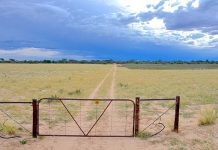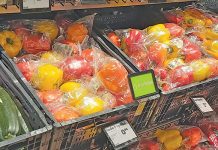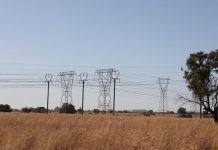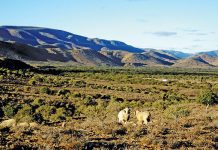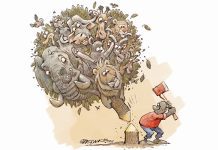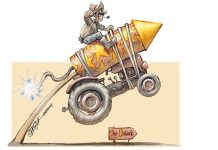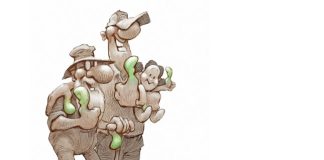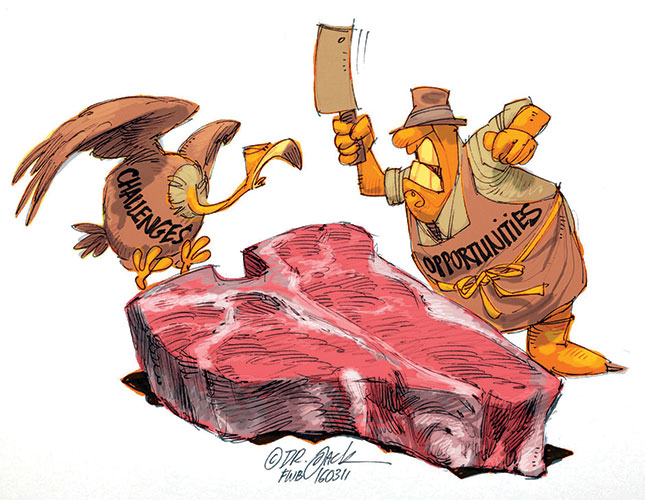
South Africa’s red meat value-chain is highly intricate. The umbrella organisation is the Red Meat Industry Forum (RMIF), under which the Red Meat Industry Trust falls. The latter manages the funds transferred from the pre-1994 Meat Board, as well as the Red Meat Research and Development Trust, the semi-government -owned SA Meat Industry Company, the Meat Statutory Measure Service, and the Red Meat Levy Admin.
Grass roots-level industry organisations are the Red Meat Producers’ Organisation (RPO) and the National Emergent Red Meat Producers’ Organisation (Nerpo), which collectively have about 70 000 members.
Other organisations include the Skins, Hides and Leather Council, the SA Feedlot Association, the SA Federation of Livestock Agents, the Association of Meat Importers and Exporters, the SA National Consumers’ Union, the Red Meat Abattoir Association, the SA Pork Producers’ Organisation (Sappo), the National Federation of Meat Traders, and the Meat Distributors and Allied Workers Union of SA.
In the 2014/2015 financial year, income from the statutory levy on red meat rose as a result of increased slaughtering due to the drought. However, income also increased because of a higher level of red meat exports. Healthy income from the statutory levy has also benefited the industry.
South Africa’s primary producers are well represented, having four of the 13 seats. These four seats are held by representatives of the large stock producers, the smallstock producers, the emerging red meat producers, and Sappo, respectively. The rest of the seats are taken up by other red meat value-chain members.
Sappo collects its own statutory levy. The RPO and Nerpo are now investigating the possibility of introducing a primary red meat producers’ levy similar to that of Sappo. Primary red meat producers contribute the majority of the red meat statutory levy budget, but do not always derive the necessary benefits funded from this budget.
If the request is approved, the primary red meat producers will use this levy income to pay for functions that benefit them directly at farm level. They would retain their seats on the RMIF, however, and continue to pay administration fees.
Exports increasing, with more to come
After South Africa regained its foot-and-mouth disease (FMD)-free status from the World Organisation for Animal Health in February 2014, red meat exports began increasing gradually. While final confirmed figures are not yet available, it is estimated that South Africa is now exporting approximately 4 000t of red meat a month to about 40 countries.
Most are in Africa, but other destinations include China, India, and the United Arab Emirates. Exports to western countries should not be a priority at present as there are far better opportunities in Africa, the Middle East and Asia.
Beef consumption in South Africa increased by 32% between 2003 and 2014. SA red meat producers should therefore position themselves to start profiting from the wide range of opportunities available. Following consultations with agricultural economists and academics, RPO forecasts that there will probably be a increase of 12% in the national beef price by the end of the year.
At the time of writing, there had already been significant increases in the beef weaner price. Lamb and mutton prices are anticipated to increase by about 10% during this year.
In late January, the national A2 beef slaughter price was listed on the Johannesburg Securities Exchange (JSE). In the first two weeks of listing, the national A2 beef slaughter price increased from R33/ kg to R42/kg on contracts for early 2016.
RPO and Nerpo have also requested that a national weaner price be listed on the JSE.
I recommend that red meat producers instruct their livestock marketing agents to utilise the A2 beef slaughter price listing and the potential weaner price listing to farmers’ advantage. Higher grain prices are detrimental to South Africa’s red
meat producers.
It takes 6kg to 7kg of maize to produce 1kg of beef. At a maize price of R4 000/t, which equals R4/ kg, the national beef price has to be at least R48/kg for a producer to cover the feed cost of maize, not to mention any of the other costs associated with beef production.
It is to be hoped that the beef price will climb as anticipated to where farmers can start making a profit, in the same way as any other business.
Customer sophistication
For South Africa’s red meat producers to take advantage of market opportunities, they need to appreciate that both local and international consumers are more sophisticated than previously thought. Our consumers increasingly talk about ‘story food’ – the story behind farm to fork. This is particularly true of younger consumers who have grown up with no exposure to agricultural production.
These consumers are also increasingly averse to food produced using growth hormones, the blanket use of antibiotics, inhumane and unethical practices, and other issues. A good ‘story’ will attract these younger consumers to particular brands of farm-grown food. They are often willing to pay a premium for such brands.
It is also important for a farmer to develop a brand for his products, have respected organisations certify his production methods, and indicate this certification on product labels. I would even recommend that a group of red meat producers in a given area join together to develop a brand under which they collectively market their certified products.
This will allow them to own their products from farm to fork, and benefit from any premiums charged for ‘story food’ products.
The time to do this is now – the market is changing.
Coping with the drought
The leading challenge currently facing the red meat industry is the drought, of course. Yes, some red producers are faring better than others, but all farmers will need to have enough feed to get through the coming winter months.
Prof HO de Waal of the University of the Free State stresses that drought-affected livestock farmers should not make sudden drastic changes to their production management systems. What is important is to cull non-pregnant breeding stock, and boost the immunity of the remaining animals.
Other challenges which the industry faces include the need to create and promote a positive image for red meat production among consumers, to develop and implement more environmentally sustainable production methods, and to have a highly effective disaster management strategy.
Other opportunities include contributing to national and even international food security, participating in and utilising animal improvement schemes, and strengthening red meat industry-related research and development programmes.
Phone Dr Pieter Prinsloo on 072 430 9474, email [email protected], or visit www.rpo.co.za.

